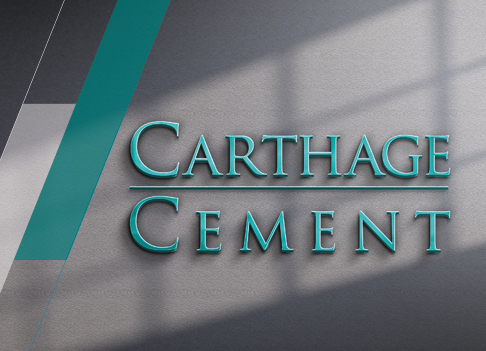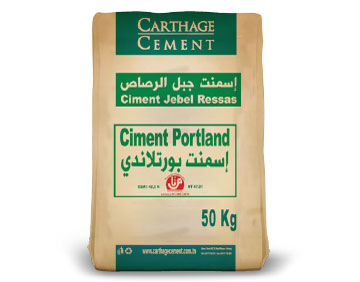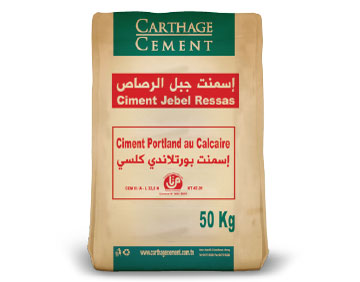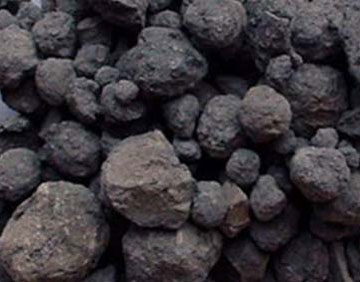Carthage Cement is equipped with state-of-the-art equipment, enabling it to ensure smooth processes, easy handling and a cost-effective production.
1. Crusher
The raw material is fed into a hammer and impact crusher (type EV) through two separate vane distributors in order to bring the two mixtures according to the predetermined set of instructions.
- Characteristics
-
| Design / specifications |
| Crusher |
EV 200X300 |
| Production flow |
1300 t/h |
| Alimentation (dim max) |
1500 mm |
| Production (dim) |
Max 5% +96 mm |
2. Raw crushing (ATOX)
For crushing raw materials, a Vertical ATOX vertical mill is used.
The ATOX raw material mill uses the pressure and the generated shear between the rollers and the turntable to crush and pound the raw materials. The feed material is directed onto the grinding table by the feed chute. The rotation of the grinding table accelerates the material towards the grinding track and passes it under the rollers.
The gas passing through the mill reaches the separator (type RAR-LVT) with very high separation performance.
- Characteristics
-
| Design / specifications |
| Broyeur |
ATOX 50.0 |
| Séparateur |
RAR-LVT 52.5 |
| Débit production |
455 t/h (sec) |
| Alimentation |
0% >175mm
MAX. 2% >150mm
Min. 30% >25mm
|
| Finesse du Cru Max |
12% + 90µm |
3. Silo homo and Food Oven
- Characteristics
-
| Design / specifications |
| silo |
CF 20 x 58 |
| Diamètre du Silo |
20 m |
| Section haute du silo |
58 m |
| Capacité silo (chaque) |
22,000 t ~ 2.4 jours consommation
|
| Système alimentation four |
Élévateur avec dépoussiéreur |
4. Oven and cooler
- Characteristics
-
| Design / specifications |
| Capacité Four |
5800 t/j |
| Préchauffeur |
2 lignes 5 étages ILC |
| Taux de calcination |
55-60% |
| Dimension four |
3-base Ø5.0m x 78m
|
| Bruleur Principal |
Duoflex pour petcoke et gas |
| refroidisseur |
SF 4x6 cross-bar |
| température clinker |
65°C (+ ambiante) |
| Conception refroidisseur pour |
5800 t/d |
| Débit transport refroidisseur |
>5800 t/d |
| Filtre de Dépoussiérage |
A manches |
| Émissions refroidisseur |
Max. 25 mg/Nm^3 |
5. Preheater, calciner and oven
Preheater :
The chosen configuration offers an energy-saving solution that takes into account the moisture content of the raw meal as well as the tower dimensions.
Online Calciner:
On-line calciners have lower NOx emissions than in-line calcination furnaces, since all exhaust gases from the furnace must pass through calcination.
Oven with three supports:
The 3-base oven is a high-quality rotary oven with three traditional supports.
Duoflex burner:
The DUOFLEX ™ burner triggers rotary ovens with pulverized pet-coke, natural gas or any mixture of these fuels.
The DUOFLEX burner is unique. It in fact carries a central duct for gaseous and liquid fuels placed inside an annular coal duct.
6. Clinker cooler. SF Cross-Bar
- Characteristics
-
| Design / specifications |
| type |
SF 4 X 6 |
| Degré de chargement |
41.8 t/d/m² |
| Air soufflé |
1.96 Nm3 air/kg clinker |
| Nombre de ventilateurs |
9
|
| Inclinaison refroidisseur |
4° |
| Température clinker |
65° C (au dessus de l’ambient) |
7. Pet-Coke Shredder
For crushing of pet-coke, a TIRAX-type grinding is proposed. It is a fully ventilated system in a closed circuit.
- Characteristics
-
| Design / specifications |
| Broyeur |
TM 42x7.25+3.6 |
| Séparateur |
RTKM 25 |
| Filter broyeur |
Bag filter |
| Limites alimentation (dim) |
Max. 5% > 25 mm |
| Type ppet-coke Pet coke |
Pet coke |
High volatile bituminous |
| Débit de Production |
33 t/h (sec) |
45 t/h (dry) |
| Finenesse produit |
Max. 3% |
Max. 12% + 90 um |
| Humidité alimentation |
Max. 8.0% |
Max. 8.0% |
| Max. Capacité séchage |
de 8.0% to 1.0% humidité |
de 8.0% to 1.0% humidité |
8. Atelier Crushing Cement
UMS Cement grinder:
- Characteristics
-
| Design / specifications |
| broyeur UMS |
50 x 15.0 |
| Séparateur |
Sepax 425 |
| Débit production |
155 t/h |
| Finesse |
320 m² /kg (Blaine)
|
| Product temperature |
105°C |
| Collecteur |
Filter à manches |
| Filtre broyeur |
Filter à manches |
Closed circuit:
The circuit includes a very high performance SEPAX 3rd generation separator.
9. Bagging Unit
Each bagging unit has the following characteristics:
- Cement is transported through a bucket elevator to a screw conveyor to the bagger.
- The machine is equipped with 08 rotary nozzles with an automatic or manual applicator.
- Each filling nozzle is equipped with its own vertical axis propeller and an electronic weighing system including automatic weighing control.
- Each bagger is connected to two forklift trucks that feed two loaders in parallel so that there’s permanently a truck for loading in order to maintain the line of conditioning with high efficiency.








